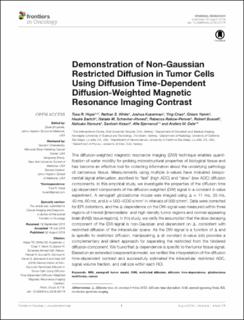| dc.contributor.author | Hope, Tuva Roaldsdatter | |
| dc.contributor.author | White, Nathan S. | |
| dc.contributor.author | Kuperman, Joshua | |
| dc.contributor.author | Chao, Ying | |
| dc.contributor.author | Yamin, Ghiam | |
| dc.contributor.author | Bartch, Hauke | |
| dc.contributor.author | Schenker-Ahmed, Natalie M. | |
| dc.contributor.author | Rakow-Penner, Rebecca | |
| dc.contributor.author | Bussell, Robert | |
| dc.contributor.author | Nomura, Natsuko | |
| dc.contributor.author | Kesari, Santosh | |
| dc.contributor.author | Bjørnerud, Atle | |
| dc.contributor.author | Dale, Anders | |
| dc.date.accessioned | 2020-06-08T13:23:27Z | |
| dc.date.available | 2020-06-08T13:23:27Z | |
| dc.date.created | 2016-11-24T18:01:24Z | |
| dc.date.issued | 2016 | |
| dc.identifier.issn | 2234-943X | |
| dc.identifier.uri | https://hdl.handle.net/11250/2657230 | |
| dc.description.abstract | The diffusion-weighted magnetic resonance imaging (DWI) technique enables quantification of water mobility for probing microstructural properties of biological tissue and has become an effective tool for collecting information about the underlying pathology of cancerous tissue. Measurements using multiple b-values have indicated biexponential signal attenuation, ascribed to “fast” (high ADC) and “slow” (low ADC) diffusion components. In this empirical study, we investigate the properties of the diffusion time (Δ)-dependent components of the diffusion-weighted (DW) signal in a constant b-value experiment. A xenograft gliobastoma mouse was imaged using Δ = 11 ms, 20 ms, 40 ms, 60 ms, and b = 500–4000 s/mm2 in intervals of 500 s/mm2. Data were corrected for EPI distortions, and the Δ-dependence on the DW-signal was measured within three regions of interest [intermediate- and high-density tumor regions and normal-appearing brain (NAB) tissue regions]. In this study, we verify the assumption that the slow decaying component of the DW-signal is non-Gaussian and dependent on Δ, consistent with restricted diffusion of the intracellular space. As the DW-signal is a function of Δ and is specific to restricted diffusion, manipulating Δ at constant b-value (cb) provides a complementary and direct approach for separating the restricted from the hindered diffusion component. We found that Δ-dependence is specific to the tumor tissue signal. Based on an extended biexponential model, we verified the interpretation of the diffusion time-dependent contrast and successfully estimated the intracellular restricted ADC, signal volume fraction, and cell size within each ROI. | en_US |
| dc.language.iso | eng | en_US |
| dc.publisher | Frontiers Media | en_US |
| dc.rights | Navngivelse 4.0 Internasjonal | * |
| dc.rights.uri | http://creativecommons.org/licenses/by/4.0/deed.no | * |
| dc.title | Demonstration of non-gaussian restricted diffusion in tumor cells using diffusion time-dependent diffusion-weighted magnetic resonance imaging contrast | en_US |
| dc.type | Peer reviewed | en_US |
| dc.type | Journal article | en_US |
| dc.description.version | publishedVersion | en_US |
| dc.source.volume | 6:179 | en_US |
| dc.source.journal | Frontiers in Oncology | en_US |
| dc.identifier.doi | 10.3389/fonc.2016.00179 | |
| dc.identifier.cristin | 1404061 | |
| dc.description.localcode | Copyright © 2016 Hope, White, Kuperman, Chao, Yamin, Bartch, Schenker-Ahmed, Rakow-Penner, Bussell, Nomura, Kesari, Bjørnerud and Dale. This is an open-access article distributed under the terms of the Creative Commons Attribution License (CC BY). The use, distribution or reproduction in other forums is permitted, provided the original author(s) or licensor are credited and that the original publication in this journal is cited, in accordance with accepted academic practice. No use, distribution or reproduction is permitted which does not comply with these terms. | en_US |
| cristin.ispublished | true | |
| cristin.fulltext | original | |
| cristin.qualitycode | 1 | |

